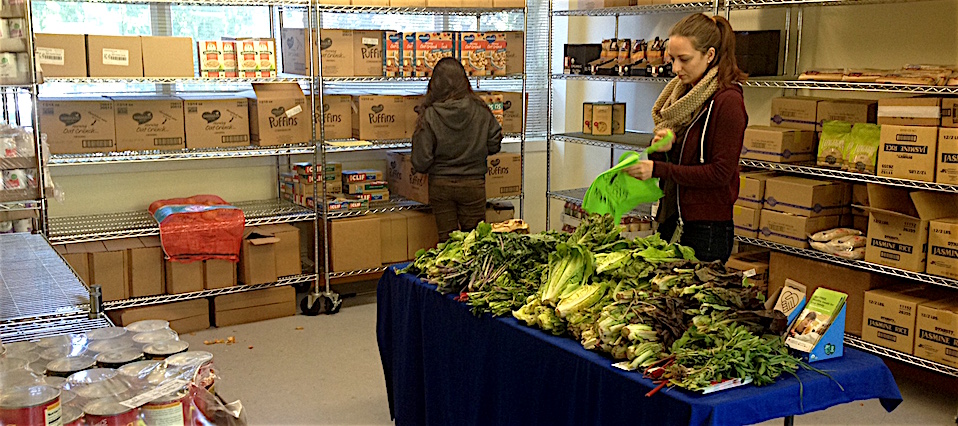For the five women running the food stalls in UC Berkeley’s Student Union, to cook is to connect, and a quick bite of lunch can hold as much history as it does flavor. As graduates of La Cocina, an SF-based incubator for restaurant entrepreneurs, they’re promised a spot at the Student Union for one academic year. The pop-ups offer a sampling of the Bay Area’s diverse food scene: a Vietnamese joint, a soul food spot, an empanada lady, a Syrian mom-and-pop, and a boutique cake shop. Each serves up a signature dish straight from the memory banks, telling the stories of their families, their childhoods, their cultures—one spoonful at a time.
PINKY AND RED’S: Sunday dinner on a bun
The first thing you notice when you step into Pinky and Red’s is the sound of soul music: Today, it’s Stevie Wonder’s Songs in the Key of Life spinning on the Crosley record player by the register. Next, it’s the sizzling smell of beef patties, the irresistible aroma of fries, and of course, the fried chicken batter crackling in oil. Then you’re greeted—“Hey baby! How you doin’? What’ll it be?”—by Pinky herself: Bernadine Sewell. “Pinky and Red, that’s my daughter and I. My hair’s pink, her hair’s red.” And indeed it is: Sewell’s hair is pulled into a neat fuschia updo, silver-dusted at the roots.

Sewell specializes in sandwiches inspired by the food she grew up on. The recipes go back six generations, handed down mother to daughter, starting in the kitchens of Louisiana, then to Detroit, then to Los Angeles where Sewell’s from. The history’s written on the walls where framed portraits of matriarchs oversee the space: Sewell as a young girl, her mother sporting a 60s bouffant, her grandmother, and then her five-times-great-grandmother posed next to the slave-owner whose kitchen she tended. That past, she says, can be distilled into one thing—the Sunday dinner. “Our concept is the Sunday dinner. We didn’t wanna see the African-American heritage lose that, because it’s such a pivotal point of our culture.”
So, Sewell took her favorites from those meals and slapped them on a sandwich. Nestled on a bed of dirty rice, sweet yams, and stewed greens, crispy and juicy on a grilled buttered bun, rests the star of the show: the fried chicken fillet. No matter how it was eaten, fried chicken was always a staple at the dinner table. And set to a soundtrack of classic funk, a mouthful sends you into a Motown daydream. “It’s the coolest music,” says Sewell. “Students can just come in, sit down, eat, pop in an album. And for those 10 minutes, they’re not in class.”
Paired with a refreshing blueberry lemonade, it’s food for the soul.
NOODLE GIRL: Slow pho
Noodle Girl was founded in 2016, but for the noodle girl herself, owner Hang Truong, the story goes back to her childhood. Growing up in south Vietnam, Truong and her family owned a restaurant. While her mother made soup, young Truong washed the vegetables and rode her bike in the wee hours of the morning to pick up noodles.

“It was so much fun. I miss that time so much,” she recalls.
When Truong moved to the United States and started a family, she began to worry about how to make her food healthy. “I didn’t start cooking until I got married. Then I had to think about how do I cook for my husband? How do I feed my kid? Then I circled back to my memory—How do I cook good food?” Figuring out what to cook for her husband was particularly important when he fell ill. “My husband was sick. He had cancer—it was stage 4. He couldn’t eat anything except soup. I cooked soup so he could survive for a couple months, because he couldn’t eat anything else. After he passed away, I wanted to bring something different from other Vietnamese restaurants.”
The dishes at Noodle Girl include beef bahn mi and various types of pho and noodle salad. Truong chooses healthy ingredients and simmers her beef pho broth for 18 hours.
The result is a rich, hearty, flavorful broth. The dish boasts a complex flavor profile with a wide range of ingredients, from thai basil, with its licorice-like taste, to fish sauce.
“You’re not just making money, you want something with a lot of care,” Truong explains. “So, you don’t worry when you eat my soup. Every step, I take my time and do it carefully. The quality, the ingredients that I choose, I would choose something that has good quality for health and for serving the community. That’s very important for me. Not only as a business owner—it’s a passion of mine.”
A GIRL NAMED PINKY: Cupcakes with a smile
Lemon tarts, macaroons, cakes, and cookies—it’s a sugar lover’s dream. And maybe a student’s too, especially delivered by the personable owner of A Girl Named Pinky, Tina Stevens.

Behind the kaleidoscopic array of delectable treats is Stevens herself, smiling in her signature black apron, hair pulled back into a bun. Her story begins in another bakery, Neldam’s in Oakland, which she used to visit often because the icing on the cakes wasn’t too sweet. But it closed in 2010, and not long after Stevens, who was engaged, was on the market for a wedding cake. Disappointed by all the samples she tried, she remembered how much she loved Neldam’s icing and decided to make her own cake.
“I started baking and coming up with my own recipes to try to mimic what I felt was missing when they closed,” she explains.
Her wedding cake experience became the catalyst for A Girl Named Pinky. Stevens started getting cake requests from her family and friends, and eventually she was able to grow her baking into a business.
Growing up in a family of entrepreneurs, she had the confidence needed to run her own shop, which started in her own kitchen before moving to pop-ups in Old Oakland and its current spot in the Student Union. The name itself has nothing to do with baking but refers to a comic book character named Pinky that Stevens’ daughter created when she was young.
Stevens grew to enjoy the customer service part of the job and loves hand-delivering her creations. She smiles remembering one student who thanked her with a handwritten card and a bottle of lotion.
“I’m in the happiness business,” she says.
OLD DAMASCUS FARE: Crispy kibbeh
They came to Oakland as refugees, displaced by civil war and never expected to make their livelihood feeding strangers food from their native Syria.

Mohammed Aref Rawas and his wife Rawaa Kasedah once lived comfortably in Damascus—he was a successful clothing manufacturer, and she took care of their home and four children. But in 2012, the riptides of war swept the family to Jordan. With guidance from the UN, the family became one of the first Syrian refugees to settle in Oakland in 2015.
“The struggle was finding a job that would meet their expectations,” said Batool Rawoas of her parents. “When we came, we didn’t know anyone.”
The family broke bread with the local Arab community and after a year of minimum wage jobs and Uber shifts, they began catering their friends’ parties. “It was informal at first, but we started getting requests from corporate clients, who needed a paper trail,” Rawoas said. She undertook the frustrating process of making a catering company—managing food safety bureaucracy and endless paperwork—all while taking a full schedule at Berkeley City College.
Eventually, Old Damascus Fare was born. And it wasn’t long before La Cocina noticed the company and tapped them for the pop-up project at the Student Union.
Rawoas says one of her family’s goals is to dispel shallow preconceptions of Arabic food. “It’s not just falafel, tabbouleh, and hummus.” Ever had beef mandi? It’s a student favorite: a heap of steamed basmati, charcoal-smoked then spiced with a carefully composed medley of turmeric, saffron, ginger, clove, and cardamom. Glistening atop it all is cubed beef so tender that its name, mandi, is derived from the Arabic word for ‘dew.’
But kibbeh, Rawoas says, is her family’s staple and signature dish. She recalls happier times of home in Damascus, when her family would make kibbeh to mark the end of Ramadan at Eid celebrations. The stuffed croquette is popular across the Mediterranean, infinitely versatile, and every family has their own recipe. Rawoas’ family uses a spiced bulgur wheat dough, stuffed with sweet-savory-scrumptious beef. The croquettes are crisped in the deep fryer and served with adas, a hearty lentil soup.
EL MESÓN DE VIOLETA: Empanadas Chilean style
When you bite into an empanada from El Mesón de Violeta, you get a taste of Chile. With its rich pastry coating and savory stuffing of caramelized onions, raisins, olives, hard boiled eggs, and various types of meats or vegetables, this empanada is distinctly Chilean—something Carmen Figueroa, shop owner and empanada connoisseur, wants to emphasize. Although empanadas can be found all over South America (relics brought to the continent from the Old World), she explains, each country has found a way “to adapt the empanada, using their own ingredients.”

“Our empanadas traditionally are baked—not fried. And we also use beef. I use top sirloin. And it goes from there.”
Figueroa was born in Santiago, Chile where she grew up surrounded by food, watching her grandmother make baked goods in the kitchen. “Empanadas, where I come from,” she says, “they’re like a Sunday thing. Family gathers around the table, we eat, we talk about the family, kids, gossip, drink a little wine.” (The importance of gathering is highlighted in the name of the eatery itself: “el mesón” means inn or tavern in Spanish.)
At the table, Figueroa remembers her grandfather telling stories of life in Spain under Franco’s dictatorship. Meanwhile, she was experiencing similar horrors under Chile’s “military junta.” She began participating in demonstrations against the regime and became a student organizer in college. In 1991, she moved to the states and began her culinary career.
At Berkeley, she enjoys that the students are open to eating food they’ve never seen before. And the diversity goes both ways, Figueroa says.
“That’s what I love about this place—you get to serve people from all over the world.”




















